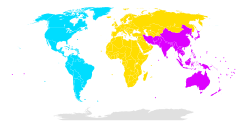List of notable frequencies

- 10.3681 GHz Region 2 narrow band calling frequency [2] [3]
- 10.3682 GHz Region 1 narrow band calling frequency [4]
- 10.3683 to 10.3684 GHz Region 2 propagation beacons [2] [3]
- 10.36875 to 10.36899 GHz Region 1 propagation beacons [4]
Wideband FM Channels
Common Wideband FM frequencies used with gunnplexers.
Operation is in full-duplex with a 30 or 90 MHz split:
- 10.220 GHz
- 10.250 GHz †
- 10.280 GHz †
- 10.310 GHz
- 10.340 GHz
- 10.370 GHz ‡
- 10.400 GHz
- 10.430 GHz
† Most commonly used frequency pair for gunnplexers in North America. (10.200 to 10.300 GHz is reserved for gunnplexers in the ARRL Band Plan. [3] )
‡ Should only be used if interference is not caused to narrow-band stations.